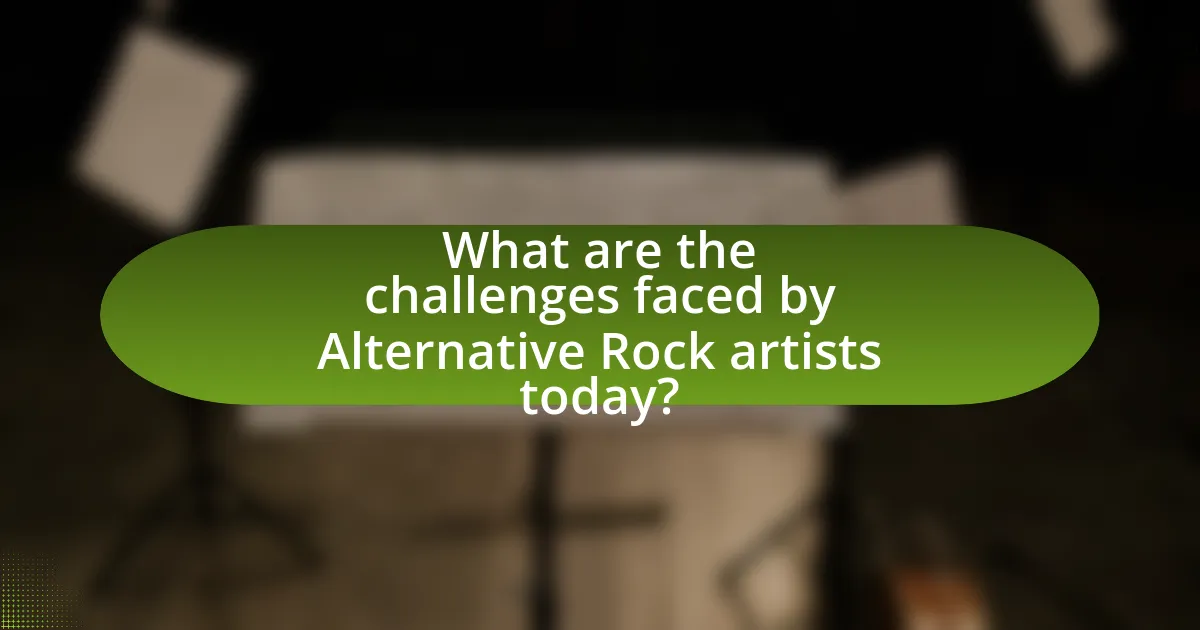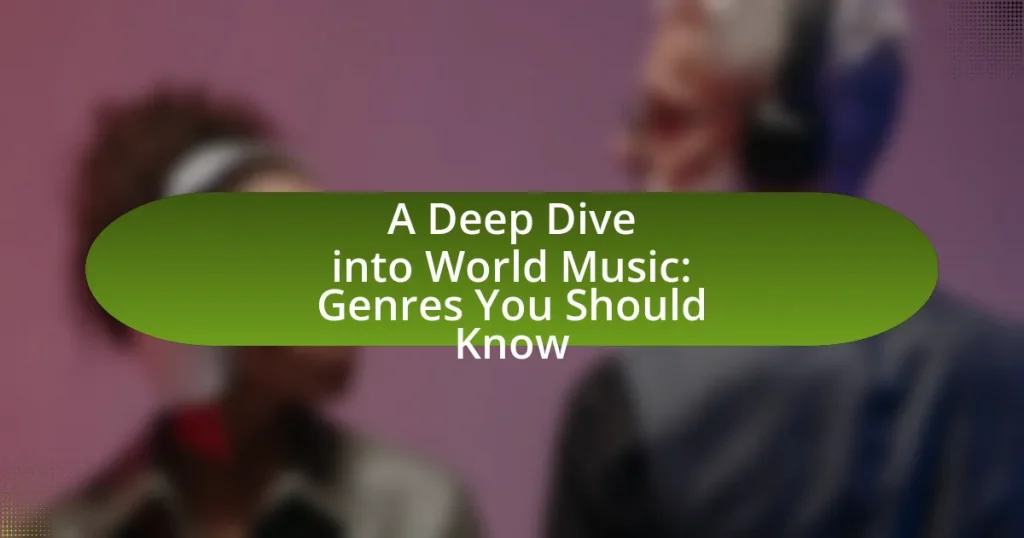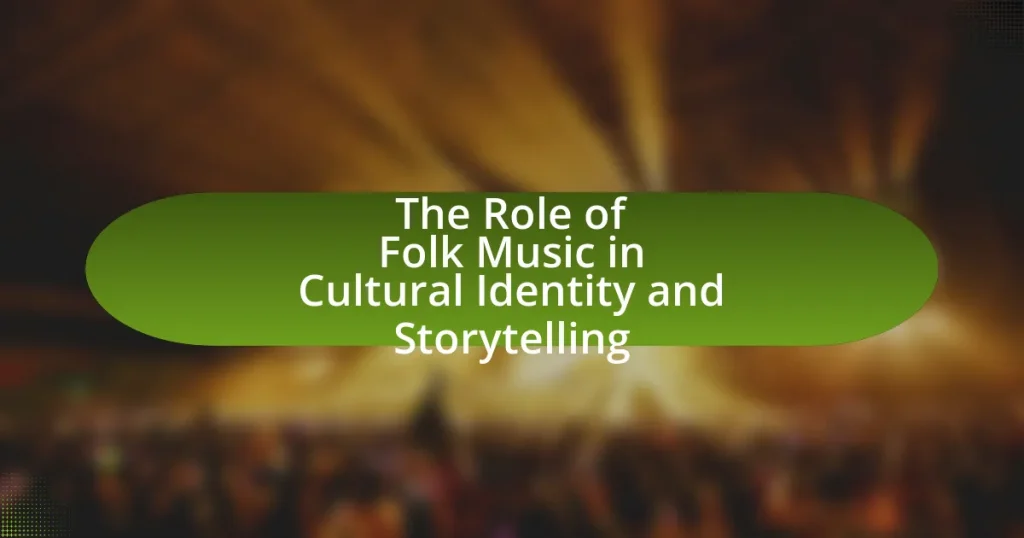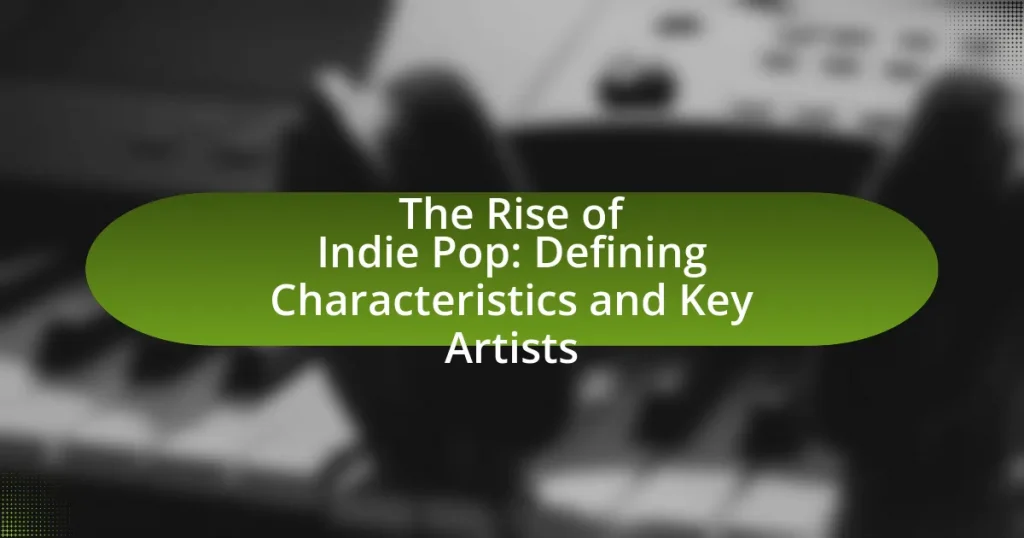Alternative Rock is a genre defined by its eclectic sound, blending influences from punk, post-punk, new wave, and grunge, characterized by unconventional song structures and introspective lyrics. The genre emerged in the 1980s and 1990s, emphasizing artistic expression over commercial appeal, with notable bands like R.E.M. and Nirvana addressing social issues and personal experiences. This article analyzes the defining characteristics of Alternative Rock, including its differentiation from mainstream rock, the significance of subgenres, the impact of the DIY ethic, and the evolution of the genre over the decades. Additionally, it explores contemporary challenges faced by artists, the role of social media and streaming platforms, and strategies for success within the Alternative Rock scene.

What are the defining characteristics of Alternative Rock?
Alternative Rock is characterized by its diverse sound, often blending elements from various genres such as punk, post-punk, new wave, and grunge. This genre typically features unconventional song structures, introspective lyrics, and a focus on artistic expression over commercial appeal. Historically, bands like R.E.M. and Nirvana exemplified these traits, with their music often addressing social issues and personal experiences, which resonated with a generation seeking authenticity. The genre’s emergence in the 1980s and 1990s marked a departure from mainstream rock, emphasizing individuality and experimentation, which has continued to influence contemporary artists.
How does Alternative Rock differ from mainstream rock genres?
Alternative Rock differs from mainstream rock genres primarily in its emphasis on experimentation and diversity in sound, often incorporating elements from various musical styles such as punk, post-punk, and indie. This genre typically prioritizes artistic expression over commercial appeal, leading to a more eclectic range of themes and lyrical content. For instance, while mainstream rock often adheres to conventional song structures and themes of love and rebellion, Alternative Rock frequently explores introspective, abstract, or socially conscious topics, as seen in the works of bands like Radiohead and Nirvana. The rise of Alternative Rock in the 1980s and 1990s, particularly through the influence of independent labels, further solidified its distinction from mainstream rock, which is often dominated by major record companies and commercial radio.
What musical elements distinguish Alternative Rock?
Alternative Rock is distinguished by its diverse musical elements, including unconventional song structures, varied instrumentation, and a blend of genres. This genre often incorporates elements from punk, post-punk, new wave, and grunge, leading to a sound that is both eclectic and innovative. For instance, the use of dissonant chords and non-standard time signatures is common, as seen in bands like Radiohead and Sonic Youth. Additionally, Alternative Rock frequently features introspective and abstract lyrics, which contrast with mainstream rock’s more straightforward themes, exemplified by artists such as The Smashing Pumpkins and R.E.M. These characteristics collectively contribute to the genre’s identity, setting it apart from more commercial rock styles.
How do lyrical themes in Alternative Rock set it apart?
Lyrical themes in Alternative Rock set it apart by emphasizing introspection, social commentary, and emotional authenticity. This genre often explores complex feelings and societal issues, diverging from mainstream rock’s more commercial and simplistic narratives. For instance, bands like Radiohead and Nirvana have addressed topics such as alienation, mental health, and existential angst, which resonate deeply with listeners seeking relatable and thought-provoking content. The focus on personal and often darker themes distinguishes Alternative Rock from other genres, making it a platform for artistic expression that challenges conventional norms.
What role do subgenres play in Alternative Rock?
Subgenres play a crucial role in Alternative Rock by providing diversity and allowing for the exploration of various musical styles and themes. This genre encompasses a wide range of subgenres, such as grunge, shoegaze, and indie rock, each contributing unique elements that shape the overall sound and cultural significance of Alternative Rock. For instance, grunge emerged in the late 1980s and early 1990s, characterized by its raw sound and themes of disillusionment, which resonated with a generation and influenced mainstream music. Similarly, shoegaze, known for its ethereal soundscapes and heavy use of guitar effects, expanded the sonic possibilities within the genre. The existence of these subgenres not only enriches the musical landscape but also allows artists to express their individuality and connect with specific audiences, thereby enhancing the genre’s relevance and longevity in the music industry.
Which subgenres are most influential in the Alternative Rock scene?
The most influential subgenres in the Alternative Rock scene are grunge, post-punk, and indie rock. Grunge emerged in the late 1980s and early 1990s, characterized by its raw sound and themes of disillusionment, with bands like Nirvana and Pearl Jam leading the movement. Post-punk, which developed in the late 1970s, introduced experimental elements and a focus on artistic expression, influencing bands such as Radiohead and The Cure. Indie rock, gaining prominence in the 1990s, emphasizes DIY ethics and artistic freedom, with notable acts like Arcade Fire and Death Cab for Cutie shaping its landscape. These subgenres have significantly impacted the sound, themes, and cultural relevance of Alternative Rock.
How do these subgenres reflect cultural and social movements?
Subgenres of alternative rock reflect cultural and social movements by embodying the sentiments and issues prevalent during their emergence. For instance, grunge music in the early 1990s expressed disillusionment and angst among youth, mirroring the economic struggles and societal changes of the time, particularly in the Pacific Northwest. Similarly, punk rock, which originated in the 1970s, served as a reaction against mainstream culture and political discontent, promoting messages of rebellion and individuality. These subgenres often address themes such as identity, social justice, and anti-establishment sentiments, resonating with listeners who identify with these cultural shifts. The lyrical content and musical styles of these subgenres provide a platform for marginalized voices, reflecting broader societal movements like feminism, LGBTQ+ rights, and anti-capitalism, thus reinforcing their connection to the cultural landscape.
Why is the DIY ethic significant in Alternative Rock?
The DIY ethic is significant in Alternative Rock because it embodies the genre’s core values of independence and authenticity. This approach allows artists to create and distribute music outside of traditional commercial frameworks, fostering a sense of community and self-expression. Historically, bands like Sonic Youth and Nirvana exemplified this ethos by recording in home studios and releasing music on independent labels, which contributed to the genre’s identity as a countercultural movement. The DIY ethic not only empowers musicians to maintain creative control but also encourages fans to engage directly with the music scene, reinforcing the genre’s grassroots nature.
How has the DIY approach shaped the production of Alternative Rock music?
The DIY approach has significantly shaped the production of Alternative Rock music by empowering artists to create and distribute their work independently. This independence allows musicians to experiment with sound and style without the constraints of major label expectations, leading to a diverse range of subgenres within Alternative Rock. For instance, bands like Sonic Youth and The Pixies utilized home recording techniques and self-released albums, which not only fostered creativity but also influenced the broader music landscape. The rise of affordable recording technology and platforms like Bandcamp has further facilitated this trend, enabling artists to reach audiences directly and maintain creative control over their music.
What impact does the DIY ethic have on artist autonomy?
The DIY ethic significantly enhances artist autonomy by empowering musicians to create, distribute, and promote their work independently. This independence allows artists to maintain creative control over their music and image, free from the constraints imposed by traditional record labels. For instance, many alternative rock bands, such as Sonic Youth and Fugazi, have successfully utilized the DIY approach to build their careers without compromising their artistic vision, demonstrating that self-released albums and grassroots marketing can lead to substantial followings and critical acclaim. This shift towards self-sufficiency not only fosters innovation but also encourages a diverse range of voices within the genre, reinforcing the idea that artists can thrive outside mainstream commercial frameworks.

How has Alternative Rock evolved over the decades?
Alternative Rock has evolved significantly over the decades, transitioning from its roots in the 1980s underground scene to a mainstream phenomenon by the 1990s and beyond. In the 1980s, bands like R.E.M. and The Smiths defined the genre with jangly guitars and introspective lyrics, establishing a foundation that emphasized artistic expression over commercial success. The 1990s saw the rise of grunge, led by Nirvana and Pearl Jam, which brought Alternative Rock into the mainstream, characterized by heavier sounds and themes of disillusionment.
In the 2000s, the genre diversified further with the emergence of subgenres such as emo and indie rock, featuring bands like My Chemical Romance and The Strokes, which introduced a blend of emotional lyrics and catchy melodies. By the 2010s, Alternative Rock incorporated electronic elements and pop influences, as seen in the works of bands like Twenty One Pilots and Imagine Dragons, reflecting broader musical trends and appealing to a wider audience. This evolution illustrates how Alternative Rock has continuously adapted to cultural shifts while maintaining its core ethos of innovation and authenticity.
What were the key moments in the history of Alternative Rock?
Key moments in the history of Alternative Rock include the emergence of the genre in the 1980s, marked by bands like R.E.M. and The Smiths, who gained popularity through college radio and independent labels. The 1991 release of Nirvana’s “Nevermind” is a pivotal moment, as it brought Alternative Rock into the mainstream, leading to the grunge movement and influencing countless artists. The late 1990s saw the rise of bands like Radiohead and Beck, who expanded the genre’s boundaries with innovative sounds and lyrical depth. The early 2000s introduced the garage rock revival with bands like The Strokes and The White Stripes, reinvigorating interest in raw, stripped-down music. Each of these moments significantly shaped the evolution and perception of Alternative Rock within the broader music landscape.
How did the 1990s define the sound of Alternative Rock?
The 1990s defined the sound of Alternative Rock through a blend of diverse musical influences, innovative production techniques, and a focus on lyrical authenticity. Bands like Nirvana, Pearl Jam, and Radiohead incorporated elements from punk, post-punk, and indie rock, creating a distinct sound characterized by raw energy and emotional depth. The rise of grunge, particularly in Seattle, showcased heavy guitar riffs and introspective lyrics, while the emergence of bands like R.E.M. and The Smashing Pumpkins highlighted melodic experimentation and genre fusion. This decade also saw the mainstream success of Alternative Rock, with albums like Nirvana’s “Nevermind” selling over 30 million copies, solidifying the genre’s cultural impact and shaping its evolution.
What influence did the internet have on the growth of Alternative Rock?
The internet significantly influenced the growth of Alternative Rock by providing a platform for independent artists to distribute their music without traditional label constraints. This democratization of music distribution allowed bands like Radiohead and The Strokes to reach wider audiences through online platforms, leading to increased visibility and fan engagement. Additionally, the rise of social media and music-sharing sites, such as MySpace and Bandcamp, facilitated the discovery of new artists and genres, contributing to the genre’s expansion in the early 2000s. According to a 2011 study by the Pew Research Center, 56% of internet users reported discovering new music online, highlighting the internet’s role in shaping listener preferences and promoting Alternative Rock’s growth.
How do contemporary artists continue to innovate within the genre?
Contemporary artists innovate within the alternative rock genre by blending diverse musical styles, utilizing advanced technology, and addressing contemporary social issues in their lyrics. For instance, artists like Billie Eilish incorporate elements of pop, electronic, and hip-hop, creating a unique sound that pushes genre boundaries. Additionally, the use of digital production tools allows for experimentation with soundscapes, as seen in the work of bands like Radiohead, who have embraced unconventional song structures and production techniques. Furthermore, contemporary lyrics often reflect current societal themes, such as mental health and identity, resonating with a modern audience and fostering deeper connections. This combination of stylistic fusion, technological advancement, and relevant subject matter exemplifies how contemporary artists continue to innovate within the genre.
What new sounds and influences are emerging in today’s Alternative Rock?
Today’s Alternative Rock is increasingly incorporating electronic elements, hip-hop rhythms, and diverse global influences. Artists are blending traditional rock instrumentation with synthesizers, sampling, and beats, creating a sound that reflects contemporary musical trends. For instance, bands like Twenty One Pilots and Imagine Dragons utilize electronic production techniques and genre fusion, which has contributed to their mainstream success. Additionally, the rise of artists such as Billie Eilish showcases a shift towards more introspective lyrics and minimalist soundscapes, further diversifying the genre. This evolution is supported by data from the Billboard charts, which indicate a growing presence of genre-blending tracks in the Alternative Rock category.
How are modern artists addressing current social issues through their music?
Modern artists are addressing current social issues through their music by incorporating themes of activism, personal experiences, and societal critique into their lyrics and sound. For instance, artists like Hozier and Billie Eilish tackle topics such as climate change, mental health, and systemic inequality, using their platforms to raise awareness and provoke thought. Hozier’s song “Nina Cried Power” highlights the importance of civil rights movements, while Eilish’s “Your Power” addresses issues of abuse and exploitation. These examples demonstrate how contemporary musicians leverage their art to reflect and respond to pressing social concerns, effectively engaging their audiences in meaningful conversations.
Why is the audience for Alternative Rock significant?
The audience for Alternative Rock is significant because it represents a diverse and engaged demographic that values authenticity and innovation in music. This genre attracts listeners who often seek alternatives to mainstream pop, leading to a strong community that supports independent artists and promotes creative expression. According to a 2020 report by Nielsen Music, Alternative Rock accounted for 7.5% of total music consumption in the U.S., highlighting its substantial impact on the music industry. This audience not only drives sales and streaming numbers but also influences trends and cultural movements, making them a vital force in shaping the future of music.
What demographics are most engaged with Alternative Rock today?
The demographics most engaged with Alternative Rock today primarily include individuals aged 18 to 34, with a notable concentration among millennials and Gen Z. According to a 2022 survey by Statista, 35% of respondents in this age group reported listening to Alternative Rock regularly, indicating a strong preference for the genre among younger audiences. Additionally, the genre attracts a diverse audience in terms of gender, with a relatively balanced representation of male and female listeners, as highlighted in a 2023 report by Nielsen Music. This engagement is further supported by the popularity of Alternative Rock playlists on streaming platforms, which have seen significant growth in followers among these demographics.
How does the fan culture of Alternative Rock differ from mainstream genres?
The fan culture of Alternative Rock is characterized by a more intimate and community-driven experience compared to mainstream genres. Fans of Alternative Rock often engage deeply with the music and its themes, fostering a sense of belonging and identity that is less prevalent in mainstream music fandoms. This is evidenced by the rise of grassroots movements, such as independent music festivals and local shows, where fans actively participate in supporting emerging artists. Additionally, Alternative Rock fans tend to prioritize authenticity and artistic expression over commercial success, which is reflected in their preference for underground bands and DIY ethics. This contrasts with mainstream genres, where fan culture often revolves around larger commercial events and celebrity-driven narratives.

What are the challenges faced by Alternative Rock artists today?
Alternative Rock artists today face significant challenges including market saturation, changing consumer preferences, and the impact of digital streaming. The music industry has seen an influx of new artists, making it difficult for established and emerging Alternative Rock musicians to stand out. Additionally, listeners increasingly favor singles over full albums, which can undermine the traditional album-centric approach of many Alternative Rock artists. The rise of platforms like Spotify and Apple Music has shifted revenue models, often resulting in lower earnings per stream compared to traditional album sales. According to a 2021 report by the Music Industry Association, streaming accounted for 83% of music revenue in the U.S., highlighting the need for artists to adapt to this new landscape.
How does the music industry impact Alternative Rock musicians?
The music industry significantly impacts Alternative Rock musicians by shaping their access to resources, promotion, and distribution channels. Major record labels often dictate the commercial viability of artists, influencing their sound and image to align with market trends. For instance, the rise of streaming platforms has altered how Alternative Rock musicians reach audiences, with data showing that over 60% of music consumption now occurs through streaming services, which can favor more mainstream sounds over niche genres. Additionally, industry support can lead to increased visibility through radio play and festival bookings, which are crucial for an artist’s growth and sustainability in a competitive market.
What barriers do independent artists face in gaining visibility?
Independent artists face significant barriers in gaining visibility, primarily due to limited access to marketing resources and industry connections. These artists often lack the financial backing that major labels provide, which restricts their ability to promote their work effectively. Additionally, the oversaturation of the music market makes it challenging for independent artists to stand out, as they compete against well-established acts with substantial promotional budgets. Research indicates that independent musicians often rely on social media and grassroots marketing, which can be less effective in reaching wider audiences compared to traditional marketing strategies employed by larger labels. Furthermore, the algorithms of streaming platforms can favor popular artists, making it difficult for independent musicians to gain traction.
How do streaming platforms affect the reach of Alternative Rock?
Streaming platforms significantly enhance the reach of Alternative Rock by providing artists with global exposure and accessibility to diverse audiences. These platforms, such as Spotify and Apple Music, allow listeners to discover new music through curated playlists and algorithm-driven recommendations, which can lead to increased streaming numbers for Alternative Rock bands. For instance, in 2020, Spotify reported that over 60% of its users discovered new artists through its playlists, demonstrating the platform’s role in promoting genres like Alternative Rock. Additionally, the data from the Recording Industry Association of America (RIAA) indicates that streaming accounted for 83% of the music industry’s revenue in 2020, underscoring the importance of these platforms in driving the popularity and financial success of Alternative Rock artists.
What role does social media play in promoting Alternative Rock?
Social media plays a crucial role in promoting Alternative Rock by providing platforms for artists to share their music directly with fans, bypassing traditional media channels. This direct engagement allows musicians to cultivate a dedicated following, as evidenced by the rise of bands like Twenty One Pilots and Arctic Monkeys, who gained significant traction through platforms like YouTube and Twitter. Additionally, social media facilitates the viral sharing of music, enabling tracks to reach wider audiences quickly; for instance, the song “Stressed Out” by Twenty One Pilots gained millions of views on YouTube, contributing to its chart success. Overall, social media serves as an essential tool for Alternative Rock artists to enhance visibility, connect with fans, and promote their work effectively.
How can artists effectively use social media to connect with fans?
Artists can effectively use social media to connect with fans by engaging them through authentic content and interactive communication. By sharing behind-the-scenes glimpses, personal stories, and exclusive updates, artists foster a sense of intimacy and community. Research indicates that 70% of consumers feel more connected to brands when the CEO is active on social media, highlighting the importance of personal engagement. Additionally, utilizing features like live streams, Q&A sessions, and polls encourages direct interaction, making fans feel valued and heard. This approach not only strengthens fan loyalty but also enhances the artist’s visibility and reach within the alternative rock genre.
What are the risks and rewards of social media engagement for musicians?
Social media engagement for musicians presents both significant risks and rewards. The primary reward is increased visibility and audience reach; for instance, musicians can connect with millions of potential fans globally, as evidenced by a 2021 report from the International Federation of the Phonographic Industry, which noted that 70% of music discovery occurs through social media platforms. Conversely, the risks include negative public perception and potential backlash, as seen in cases where artists faced criticism for controversial posts, leading to loss of sponsorships or fan support. Thus, while social media can enhance a musician’s career through broader engagement and promotional opportunities, it also poses challenges that can adversely affect their reputation and financial stability.
What strategies can Alternative Rock artists employ to succeed?
Alternative Rock artists can succeed by leveraging social media for direct fan engagement, utilizing streaming platforms for wider distribution, and collaborating with other artists to expand their reach. Social media allows artists to build a loyal fanbase by sharing content and interacting with followers, which is crucial in a genre that thrives on community. Streaming platforms like Spotify and Apple Music provide access to global audiences, enabling artists to gain exposure without traditional record label constraints. Collaborations with other musicians can introduce artists to new audiences and create unique sounds that resonate with listeners. These strategies are supported by the rise of independent artists who have successfully navigated the music industry using similar approaches, demonstrating their effectiveness in achieving success in the Alternative Rock genre.
How can artists balance artistic integrity with commercial success?
Artists can balance artistic integrity with commercial success by strategically aligning their creative vision with market trends while maintaining authenticity. This involves understanding audience preferences and industry dynamics, allowing artists to create work that resonates commercially without compromising their core values. For instance, many successful alternative rock bands, such as Radiohead, have embraced innovative approaches to distribution and marketing, like releasing albums independently or utilizing digital platforms, which allows them to retain creative control while reaching wider audiences. This dual approach demonstrates that it is possible to achieve commercial viability while staying true to one’s artistic identity.
What best practices can emerging artists follow in the Alternative Rock scene?
Emerging artists in the Alternative Rock scene should focus on developing a unique sound and authentic identity. This involves experimenting with various musical styles and influences to create original compositions that resonate with their personal experiences. Additionally, building a strong online presence through social media platforms and music streaming services is crucial, as it allows artists to connect with their audience and promote their work effectively. Engaging with local music communities and participating in live performances can also enhance visibility and foster networking opportunities. According to a 2021 survey by the Music Industry Research Association, 70% of emerging artists reported that social media significantly impacted their ability to reach new fans, highlighting the importance of digital engagement in today’s music landscape.



